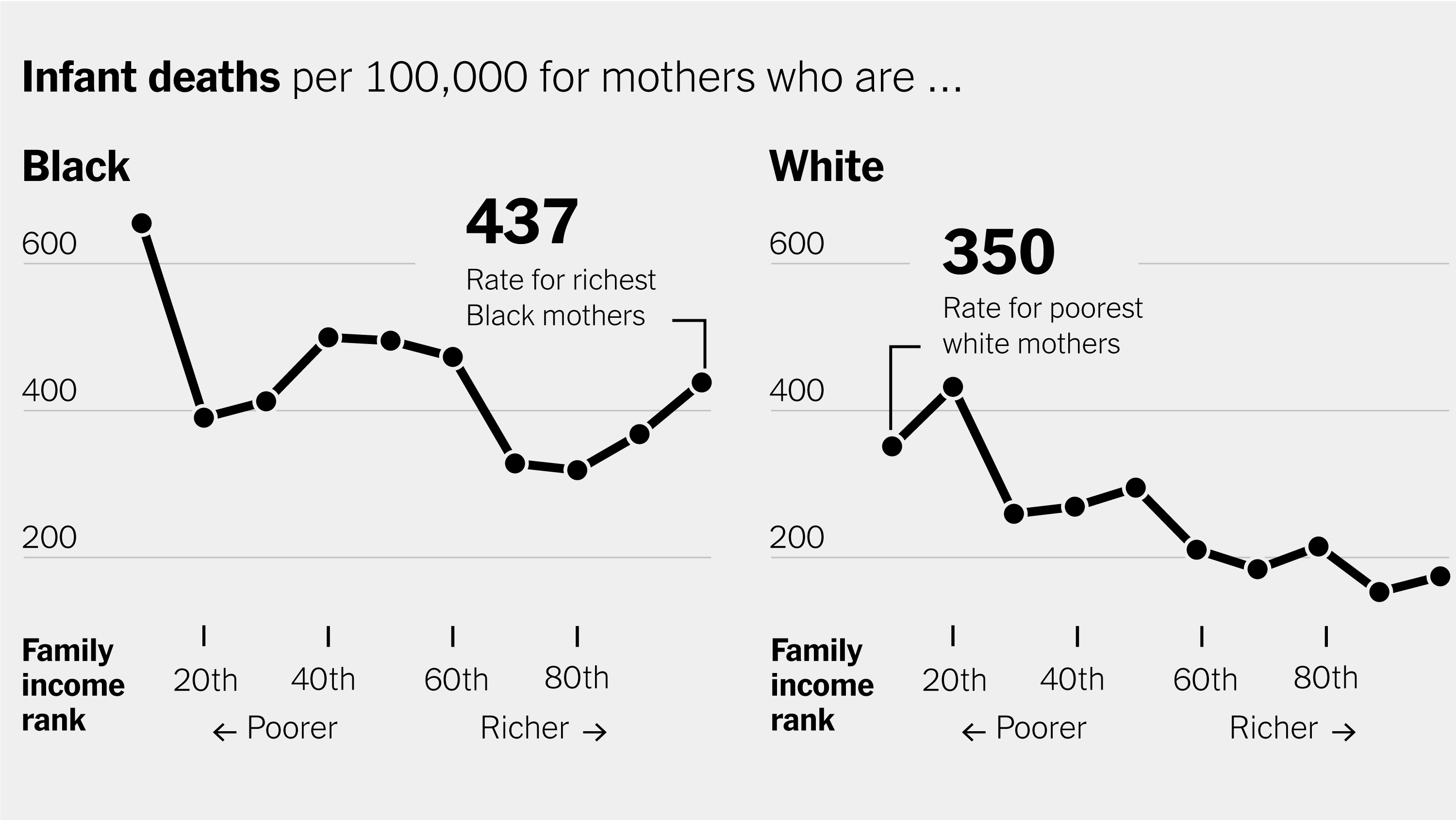Black infant mortality rates present a stark and urgent public health issue, reflecting profound healthcare inequalities that significantly affect Black Americans. A recent study reveals that Black infants currently face a mortality rate that is 115 percent higher than that of their white counterparts, a troubling increase since the 1950s. Despite improvements in life expectancy across both racial groups, Black infants are disproportionately impacted by preventable medical conditions related to pregnancy and healthcare access. This widening racial disparity in healthcare highlights systemic flaws in public health policy that demand immediate attention and action. Addressing these alarming infant mortality statistics is essential to improving health outcomes and achieving greater equity in healthcare for all communities.
The alarming rates of infant deaths among Black infants underscore critical challenges within our healthcare system. Recent data indicates that the gap in infant mortality between race groups has broadened, with infants from Black families experiencing mortality at rates significantly higher than their white peers. This troubling trend points to broader issues surrounding healthcare equality and the persistent racial disparities that plague public health. As the United States grapples with its history of systemic racism and inequality in health outcomes, understanding the factors contributing to these inequities becomes increasingly vital. In order to forge a path toward healthier futures for all, focused research and innovative public health efforts are essential.
Understanding Black Infant Mortality Rates
Black infant mortality rates remain a pressing issue in public health, particularly highlighting the disparities faced by Black families in the United States. Recent studies report that Black infants die at a rate that is twice that of their white counterparts, reflecting deep-rooted inequalities in healthcare access and outcomes. With a significant portion of these deaths attributed to preventable medical conditions during pregnancy, the need for targeted interventions becomes critical. Understanding these statistics is essential not only for healthcare providers but also for policymakers looking to implement effective public health strategies.
The data underscores a troubling trend: despite overall improvements in life expectancy for Black Americans, the gap in infant mortality has widened since the 1950s. This scenario presents a complex challenge; it indicates that while systemic enhancements may have been made in adult healthcare, similar progress has not translated effectively for Black infants. Addressing this multifaceted issue requires a concerted effort to analyze the reasons behind these disparities and implement robust programs aimed at ameliorating neonatal health outcomes for Black families.
Racial Disparity in Healthcare and its Impact
Healthcare inequality is a significant factor contributing to the racial disparity in infant mortality rates. Black Americans often face barriers to accessing quality healthcare, which can lead to an increased risk of complications during pregnancy and childbirth. Issues such as socioeconomic status, geographic location, and discrimination within healthcare settings severely impact the quality of care that Black families receive. These disparities in healthcare access not only affect adults but have devastating consequences for infants, manifesting in alarming mortality rates.
Public health policy must acknowledge these inequalities and work towards dismantling the systemic barriers that perpetuate them. This requires not only improved access to healthcare but also quality assurance within healthcare settings. Stricter regulations and better funding for healthcare facilities that serve Black communities are essential steps to ensure that all infants receive the care they need. Additionally, training healthcare providers on cultural competence can help to minimize implicit biases and improve the overall treatment of Black infants and their mothers.
Long-term Trends in Infant Mortality Statistics
Analyzing infant mortality statistics over decades reveals a concerning trajectory for Black infants. While the life expectancy of Black Americans has improved significantly since the 1950s, infant mortality rates have not followed suit, with the current rate being 115 percent higher than that of white infants. This comparison illustrates the inadequacies in healthcare provisions for Black families and emphasizes the need for ongoing research and intervention strategies aimed at closing this gap.
Long-term trends in healthcare data can inform future public health initiatives aimed at reducing infant mortality rates among Black infants. By examining historical contexts alongside current healthcare policies, researchers can identify patterns and factors that contribute to these disparities. Knowing that the gap has persisted may leverage greater funding and resources toward effective programs designed to facilitate better prenatal and postnatal care for Black mothers and babies, ultimately saving lives.
Addressing Healthcare Inequality for Better Outcomes
Tackling healthcare inequality is not just a matter of public concern but a public health imperative that could lead to better health outcomes for Black Americans. Policymakers must confront the underlying causes of disparities in healthcare to provide equitable care to all populations. Analyzing factors such as access to obstetric services, affordability of prenatal care, and continuity of care can illuminate the pathways leading to improved infant mortality rates.
One potential solution is to expand Medicaid coverage and access to services focusing on maternal health, especially in underserved areas where Black families often reside. Ensuring that women receive comprehensive prenatal care can help address complications before they arise. Moreover, community engagement initiatives that include educating expectant parents about available healthcare resources could empower families to seek the assistance they need.
Public Health Policy Reforms Needed
In light of the alarming infant mortality statistics and persistent healthcare inequality, it is imperative for public health policies to be reformed. Initiatives focused on improving access to healthcare for Black families and reducing systemic barriers are crucial. Policymakers should prioritize programs that address social determinants of health, including education, socioeconomic status, and neighborhood safety, as these have profound impacts on maternal and infant health outcomes.
Additionally, creating targeted health campaigns that address culturally specific needs and highlight available resources can drive awareness and usage of healthcare services. Public health officials can mobilize community resources to implement support systems for Black mothers, such as home visitation programs and maternal health education workshops, thereby improving outcomes for Black infants and decreasing the mortality rate.
The Role of Research in Highlighting Disparities
Research plays a critical role in understanding and addressing disparities in healthcare, particularly regarding Black infant mortality rates. Comprehensive studies like the one conducted by Soroush Saghafian provide invaluable data that can inform public health policy and priorities. By collecting long-term data, researchers can distinguish between short-term fluctuations and entrenched patterns, showcasing the urgent need for intervention strategies.
Such research also serves as a catalyst for dialogue among health authorities, community leaders, and the general public, raising awareness of the inequalities that exist in healthcare systems. This level of transparency can mobilize resources and foster collaboration towards creating innovative solutions tailored to the specific needs of Black communities, ultimately aiming to enhance health outcomes for both mothers and their infants.
Community Engagement for Health Equity
Community engagement is essential in the push for health equity, particularly in addressing Black infant mortality rates. Local organizations can play a pivotal role in bridging the gap between healthcare providers and Black families by advocating for their health needs and ensuring that they have access to necessary services. By involving community members in health discussions, organizations can create tailored approaches that resonate with the specific experiences and cultural contexts of Black families.
Moreover, strengthening partnerships between public health entities and community organizations can facilitate outreach efforts, amplify access to critical healthcare information, and foster trust. Programs that train community health workers as liaisons can significantly enhance the connection between families and the healthcare system, ensuring that Black mothers receive the support they need to navigate complex healthcare environments and improve their infant’s health outcomes.
Future Directions for Infant Health Research
The future of infant health research must prioritize a comprehensive understanding of the unique factors impacting Black infants. More funding and resources should be allocated to studies that explore not just the medical but also social determinants of health. This means placing emphasis on the roles of economics, education, and environmental conditions in influencing maternal and infant health outcomes.
Additionally, fostering interdisciplinary collaborations among researchers, healthcare providers, and policy-makers is vital for developing effective interventions. By working together, they can address the multifaceted issues surrounding healthcare disparities and generate innovative solutions aimed at improving infant mortality rates among Black infants. Continuing the dialogue and research in this area will be crucial for applying effective public health measures.
The Path Forward: Closing the Racial Gap in Infant Mortality
Closing the racial gap in infant mortality rates requires a holistic approach that considers the health and well-being of families in its entirety. Strategies must be developed that encompass not only immediate healthcare improvements but also broader societal changes that address systemic inequalities in health. This involves empowering communities and ensuring that all families, regardless of racial or socioeconomic status, have access to comprehensive healthcare services.
Furthermore, ongoing advocacy and commitment from both healthcare professionals and policymakers are vital to effecting change. It is essential to set measurable goals for reducing infant mortality rates among Black Americans, ensuring that these targets shape healthcare agendas at all levels. By leveraging the lessons learned from long-term studies and current research, stakeholders can create meaningful strategies that will lead to improved health outcomes for future generations.
Frequently Asked Questions
What are the current Black infant mortality rates compared to white infants?
Black infant mortality rates stand at approximately twice those of white infants, indicating a significant disparity in health outcomes. Recent studies have shown that Black infants die at a rate 115% higher than white infants, highlighting ongoing racial inequality in healthcare delivery and outcomes.
What causes the racial disparity in Black infant mortality rates?
The disparity in Black infant mortality rates is influenced by multiple factors including healthcare inequality, access to quality care, and social determinants of health. Medical conditions during pregnancy have been identified as primary contributors to higher mortality rates among Black infants.
How do Black infant mortality statistics inform public health policies?
Black infant mortality statistics underline the urgent need for targeted public health policies aimed at reducing healthcare disparities. They emphasize the necessity for improved access to quality prenatal care, better maternal health education, and addressing systemic issues that disproportionately affect Black Americans.
Why has the gap in Black infant mortality rates widened over the decades?
Despite improvements in overall life expectancy, the gap in Black infant mortality rates has widened due to persistent healthcare inequalities and insufficient focused intervention on maternal and infant health for Black communities. Long-term studies reveal a lack of progress in addressing these critical issues.
What efforts are being made to address healthcare inequality affecting Black infants?
Efforts to address healthcare inequality impacting Black infants include policy initiatives aimed at expanding access to quality healthcare, increasing funding for maternal health programs, and promoting community-based interventions that educate and support Black families during and after pregnancy.
What role does public health policy play in reducing Black infant mortality rates?
Public health policy plays a crucial role in reducing Black infant mortality rates by implementing evidence-based strategies to improve maternal health, increase access to healthcare services, and eliminate systemic barriers that contribute to healthcare disparities experienced by Black Americans.
How can researchers better understand the reasons behind the disparity in Black infant mortality rates?
Researchers can better understand the underlying reasons for the disparity in Black infant mortality rates by conducting comprehensive studies that explore social determinants of health, access to healthcare, and the quality of medical care provided to Black mothers and infants. Additionally, multi-faceted approaches that involve community engagement and policy advocacy are essential.
What historical context is important for understanding Black infant mortality rates?
Understanding Black infant mortality rates requires recognizing the historical context of systemic racism and socioeconomic disparities in healthcare access that have persisted since the 1950s. Historical trends indicate that while life expectancy for both Black and white Americans has improved, the gap in infant mortality rates reflects deeper, unresolved healthcare inequalities.
What is the significance of studies analyzing infant mortality statistics over long periods?
Studies analyzing infant mortality statistics over extended periods, like the 70-year study examined, provide crucial insights into the persistent health disparities that may not be evident in short-term studies. These long-term analyses help to identify trends and underscore the need for sustained efforts to address and rectify healthcare inequalities.
How does the high Black infant mortality rate impact the larger community?
The high Black infant mortality rate not only reflects individual tragedies but also has broader implications for the community, including economic burdens, long-term health consequences, and erosion of trust in the healthcare system. Addressing this issue is critical for fostering health equity and improving overall community well-being.
| Key Point | Details |
|---|---|
| Mortality Rates | Black infants die at twice the rate of white infants. |
| Life Expectancy Improvement | Life expectancy has increased significantly for both groups since the 1950s. |
| Racial Disparity | The mortality rate gap for Black infants has widened from 92% to 115% since the 1950s. |
| Primary Cause of Infant Mortality | Medical conditions during pregnancy are the leading cause of excess deaths. |
| Healthcare Disparities | Healthcare inequality affects both access and quality of care for Black infants. |
| Need for Policy Action | Public health officials must prioritize reducing the mortality gap. |
Summary
The increasing Black infant mortality rates highlight a critical public health crisis in the U.S. Despite overall improvements in life expectancy for both Black and white populations, the mortality rates for Black infants have not only remained disproportionately high but have actually worsened over the last 70 years. It is essential for health authorities to address these disparities with effective policy changes and interventions that ensure equitable healthcare access and resources for Black families. Ignoring the widening gap in infant mortality rates could have dire consequences for future generations.








